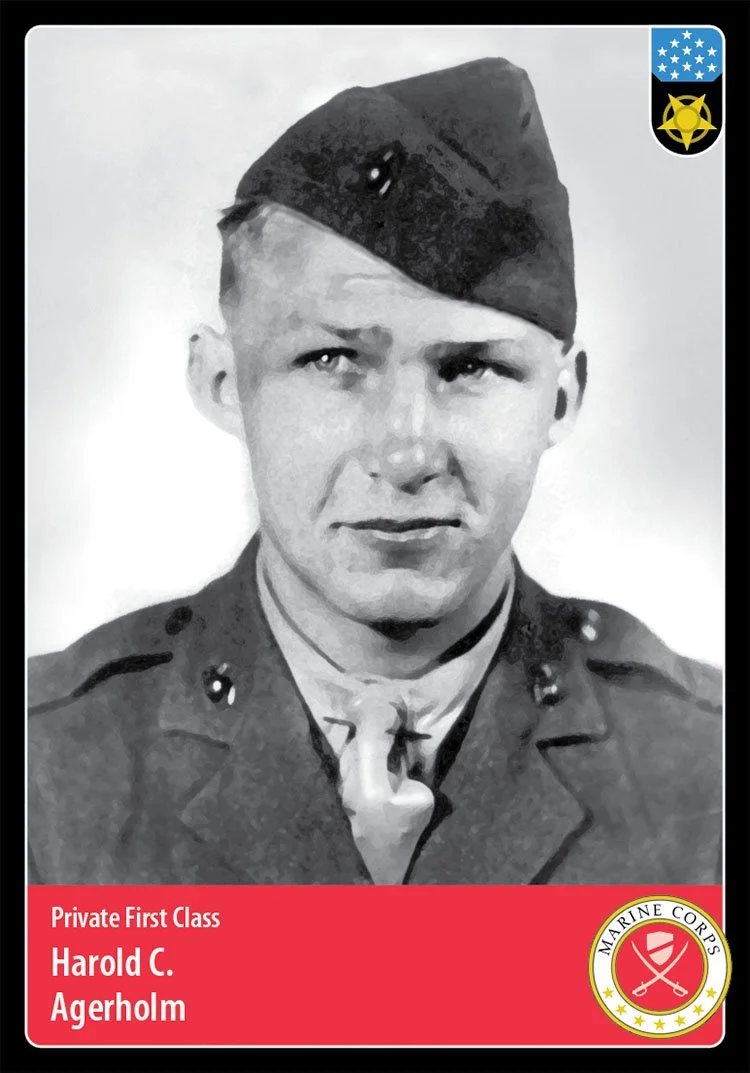Hero Card 71, Card Pack 6
Artist’s rendering by Craig Du Mez, from original photo
Hometown: Racine, WI
Branch: U.S. Marine Corps
Unit: Headquarters and Service Battery, 4th Battalion, 10th Marines, 2d Marine Division
Military Honors: Medal of Honor, Purple Heart
Date of Sacrifice: July 7, 1944 - KIA in Saipan, Mariana Islands
Age: 19
Conflict: World War II, 1939-1945
Harold Christ Agerholm was born on January 29, 1925, to Chris and Rose Agerholm in Racine, Wisconsin—less than an hour south of Milwaukee. There he attended Racine public schools. At age 17, Harold worked for five months at the Rench Manufacturing Company, operating a multigraph letterpress printing machine.
In July of 1942, in the middle of World War II, Agerholm enlisted in the U.S. Marine Corps and left for training at the Recruit Depot in San Diego, California. On November 3 of that year, he was sent to Wellington, New Zealand for eleven more months of training. He was assigned to the Headquarters and Service Battery, 4th Battalion, 10th Marines, 2nd Marine Division. By January of 1943, Agerholm had been promoted to Private First Class.
After a year and a half of training, PFC Agerholm and his battalion saw their first combat action in November of 1943. In Operation Galvanic—an offensive to take tiny Betio Island in the Gilbert Islands’ Tarawa Atoll—Americans faced their first intense opposition to an amphibious landing in the Pacific theater.
On Betio, 4,500 Japanese soldiers were well prepared and dug in, determined to fight to the death. 18,000 U.S. Marines invaded the island, taking out enemy pillboxes and fortifications. Three days of intense fighting ended with a furious Japanese “banzai” (suicide) charge—which included even the wounded Japanese soldiers.
Estimates of the Japanese deaths rise as high as 4,600—including construction workers and soldiers. The “Battle of Tarawa” shocked the Americans back home, both with the fanaticism of the Japanese soldiers fighting to the last man, and the heavy toll on U.S. forces to take the tiny island in the middle of the Pacific Ocean. More than 1,000 Marines were killed and 2,000 more wounded.
After the battle, PFC Agerholm’s 2d Marine Division sailed to the Hawaiian Islands where they trained for an invasion of Saipan in the Mariana Islands.
Seven months later, on June 10, 1944, PFC Agerholm landed with his battalion on the island of Saipan. The Marines faced more of what they encountered earlier on Betio Island, and the fighting raged on for three weeks.
On July 7, the Japanese launched a vigorous counterattack. With a nearby battalion overwhelmed and taking heavy casualties, PFC Agerholm volunteered to rescue wounded Marines. He grabbed an abandoned Jeep ambulance, and for three hours under heavy fire made repeated trips to evacuate the wounded.
After saving 45 men, PFC Harold C. Agerholm was struck down by a Japanese sniper. Just 19 years old, he was posthumously awarded the Medal of Honor. His citation reads:
For conspicuous gallantry and intrepidity at the risk of his life above and beyond the call of duty while serving with the 4th Battalion, 10th Marines, 2d Marine Division, in action against enemy Japanese forces on Saipan, Marianas Islands, 7 July 1944. When the enemy launched a fierce, determined counterattack against our positions and overran a neighboring artillery battalion, Pfc. Agerholm immediately volunteered to assist in the efforts to check the hostile attack and evacuate our wounded. Locating and appropriating an abandoned ambulance jeep, he repeatedly made extremely perilous trips under heavy rifle and mortar fire and single-handedly loaded and evacuated approximately 45 casualties, working tirelessly and with utter disregard for his own safety during a grueling period of more than three hours. Despite intense, persistent enemy fire, he ran out to aid two men whom he believed to be wounded marines, but was himself mortally wounded by a Japanese sniper while carrying out his hazardous mission. Pfc. Agerholm’s brilliant initiative, great personal valor, and self-sacrificing efforts in the face of almost certain death reflect the highest credit upon himself and the U.S. Naval Service. He gallantly gave his life for his country.
To honor the fallen Marine’s courage, a navy destroyer—the USS Agerholm (DD-826)—was commissioned on June 20, 1946. The Harold C. Agerholm Memorial Gun Park in North Carolina’s Camp Lejeune, and the Jerstad-Agerholm schools in his hometown Racine, WI, are named in his honor.
Sources
Artist’s rendering: Craig Du Mez, from original photo
Congressional Medal of Honor Society: Harold Christ Agerholm
Honor States: Harold Christ Agerholm
History Channel: Battle of Tarawa
War History Online—Harold Agerholm: Medal Of Honor recipient saved 45 of his comrades to safety before he was cut down in the prime of his life by a sniper
Burial Site: Find a Grave





